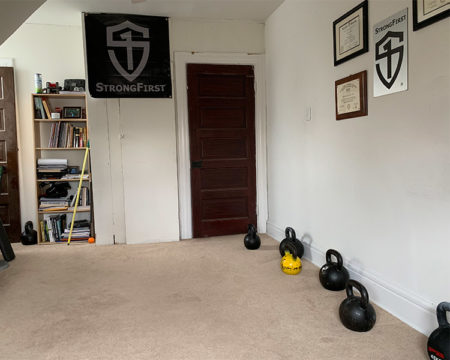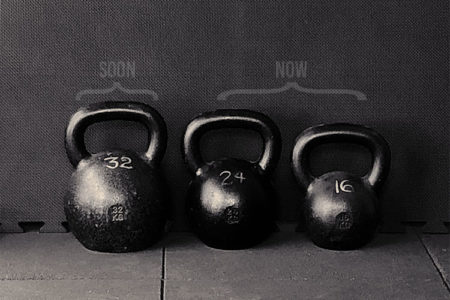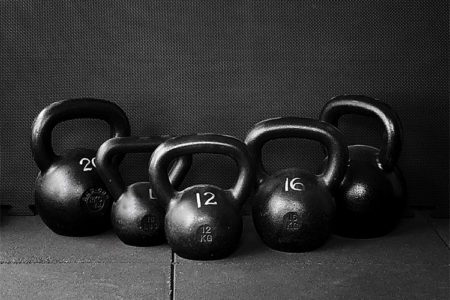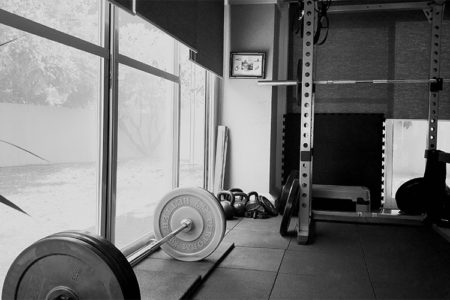I first came across the term courage corner when reading StrongFirst CEO Pavel Tsatsouline’s book The Russian Kettlebell Challenge. During his military service, Pavel saw a lot of starkly different places, from the frozen expanse of Siberia to sleek submarines under the Baltic Sea to the peaks of the Caucasus Mountains. But one thing remained constant everywhere he went: each of the bases in these places had a small training area with a few kettlebells—a courage corner. Yep, even on those submarines.
These corners were where soldiers went for 20, 30, or 40 minutes a day to perform their physical practice. Regardless of what they had been doing beforehand, once they stepped into that designated area, it was all business. The goal was to hone their skills and do some hard physical work that would keep them ready for anything. And there were no complex machines, rows of weights, or even squat racks in sight—just a few bells and a humble mat. The courage corners were not designed for show but for practicality. That’s where you went to get strong.
Being something of a minimalist myself, the concept of the courage corner appealed to me. If you could really accomplish everything you needed by moving in this small area with two or three kettlebells, I was all in. Perhaps somewhat foolishly, I bought myself just one to begin with—the trusty ol’ 24kg. In retrospect, it was a bit too heavy for a beginner, but being fairly fit I was able to use it sufficiently well within my first courage corner to prepare for and pass my SFG certification.

Back then—that makes it sound like 1901, doesn’t it? It was actually 2001—you couldn’t get all the small increments that are available today. So to expand my corner and my own capabilities I bought a “starter set” which consisted of 16, 24, and 32kg bells. Now that I had three individual weights and, adding to my initial purchase, two 24s, I had greatly expanded the variety of training sessions I could perform. And all of them could be done in this little corner of my house. Having your training area so close at hand removes all the excuses we tend to make for not sticking to a training plan like “I don’t have time to drive to the gym today.” When you have a courage corner in your home, you can train in the morning, at night, and even swing a bell for a few minutes between meetings, as I often do.

3 Steps for Setting Up Your Own Courage Corner
While the concept couldn’t be more elemental, before you go ahead and set up your in-home training nook, there are three main considerations to ponder: safety, space, and cleanliness.
1. Safety
Whenever you’re using kettlebells (or any other kind of equipment, for that matter), safety has to come first. Your courage may indeed be forged in a corner, but while the requirements are minimal, you need to make sure you position yourself and your gear in the right spot. This means somewhere that your significant other, kids, pets, or roommates won’t cut across the path of your body or bells. This would put you, them, and your floor in jeopardy. Speaking of which, doing get-ups on a hardwood or cement floor is less than pleasant, so if these types of flooring are all you have to work with, you’ll need some manner of mat. Remember that while you want to reduce the discomfort of a hard floor, the mat is mainly for safety’s sake. So you should get something firm, not squishy. I’m a big fan of interlocking judo mats (more on this in a moment). Also recognize the possibility that at some point you might drop a bell. If you heed the warning signs and don’t push past what should be a stopping point, this hopefully won’t be the case. But I don’t want you putting a dent in your nice reclaimed barn wood planks or, as a friend of mine did while maxing out on his deadlift recently, cracking your basement floor. If you share your residence with others, let them know that when the mats are down and the bells are out, you’re either training or about to be, so they need to steer clear.
2. Space
When scouting possible spots for your courage corner to reside in, nix anywhere that doesn’t give you sufficient radius to perform staple kettlebell exercises (swings, get-ups, deadlifts, presses, squats, snatches, jerks, and so on) with a full range of motion. You must have a clear working environment that’s sufficiently sized so that you don’t have to modify the drills to fit the space. This doesn’t just include the width and length of your courage corner, but also the height. While I have some athletes and fellow coaches who have to make variations to their get-ups or do their presses between beams in their basements, this is far from ideal as it adds something else for your brain to have to think about that could distract you—not what you’re looking for with a big ball of cast iron balancing above your head. So if possible, make sure you can do a full get-up, press, and snatch without the finish position putting your ceiling, lights, fans or your hand in a painful bind.
3. Cleanliness
Going back to mats for a moment, the reason I favor the interlocking judo variety is that they’re not only just the right thickness and firmness for get-ups, kneeling presses, and just about everything else you can do with a kettlebell, they also come apart easily. This allows me to break down my training surface in seconds and stash them in a cupboard when necessary. One surefire way to get your courage corner (and possibly yourself) kicked out of the house is letting it get sweaty and stinky. So be sure you’re sanitizing your mats appropriately and often, and cleaning any surrounding surfaces that might become icky when you’re getting intense or even sinister in your training. If you’re positioning your courage corner in a multi-use space (I’m talking to you, New York City micro-apartment dweller), be considerate and put away your bells and mat as soon as you’ve finished using and wiping them down.
Nail Your Bell Selection
Ah, this old chestnut again. I would like to simply write, “it depends” and leave it at that. “Well, that’s a cop-out,” I hear you mutter. OK, it is. Kinda. But there are so many variables specific to you personally that it’s hard to make blanket recommendations. These include your previous experience with kettlebell work, training age, current fitness and strength levels, and so many more factors. If you really want an answer to the age-old “Which kettlebells do I need at first?” question, we can refer to Pavel’s recommendations in Kettlebell Simple & Sinister:

As I mentioned earlier, some sellers provide kettlebell “starter packs” that include several of the weights listed above or variations with slightly smaller increments for a lower price than buying bells individually. As ever, do not let your ego dictate your bell selection. While you should challenge yourself, it would be better to get proficient with a lighter bell than you think you can handle initially and then move up, rather than trying to muscle a weight that’s too heavy and ingrain faulty technique. A certified StrongFirst coach can assess where you’re at and provide personalized recommendations that go beyond what I can suggest without knowing your capabilities.

Once you are ready to add heavier bells, don’t discard the ones you already have, as they can be useful for warming up, higher volume sessions, programs like Strong Endurance, and for specialized variety training like bottoms-up, athletic drills, etc. Plus, they’re great to have when you invite a curious guest into your corner. While you can accomplish most everything you would want to do with two or three bells, a few more will provide an even greater range of possibilities (I confess that I currently have nine in my home office/courage corner, while hoping my wife isn’t seeing me type this).
Training Alone
Isolation can be one of the hardest things on the human psyche. It can also be where profound skill, focus, and progress can be found.
“I think it’s very healthy to spend time alone. You need to know how to be alone and not defined by another person.”
Oscar Wilde
This can be very valuable from a training perspective. Whether we like to admit it or not we can modify our actions (and plans) under public scrutiny. When others are watching and we want to “impress,” we may choose to continue a set beyond where we should, or add a bit of weight to a previously planned session. Alone and out of the public eye we have a better chance of sticking to the plan.
Our ability to be mindful during training is also enhanced in my opinion. Over the last 20 years or so I have predominately trained alone. (Don’t cry for me—it was a combination of choice and circumstance) And I feel it has been key to my learning and progress. But we don’t always have to train alone. Having a strength community (like a StrongFirst Accredited Gym, SF Instructor, and our online Forum and Facebook Group communities) can drive us to accomplish things we may not on our own. There is an African proverb: “If you want to go fast, go alone. If you want to go far, go together.” A solid perspective for training perhaps.
“The hardest walk you can make is the walk you make alone, but that is the walk that makes you the strongest.”
Attributed to multiple sources
Conclusion: Screw Your Courage to the Sticking Place
Hopefully this article has proved helpful in selecting the right location and equipment for your courage corner. Once you’ve chosen your space, bells, and mats, it’s go time. Make sure that when you enter your courage corner, you’re ready to learn and put in the effort required to progress. Something that can help is tailoring the environment so it’s more conducive to focused effort. This includes making sure you’re training in a part of your home that is inviting and that you enjoy being in—so not that dank, dingy corner of your basement with all the spiders.

Other things that can encourage you to train more consistently include getting the lighting right and recognizing whether you’re a little bit country or a little bit rock and roll (it’s a reference to The Osmonds, kids) with your music preferences. For example, Pavel prefers blasting heavy metal while he’s busting out swings and get-ups, whereas I’ve recently been revisiting Queen’s back catalog after watching Rami Malek’s Oscar-winning performance in Bohemian Rhapsody. Find some music—or if training is a more meditative experience for you, perhaps silence—that gets you in the mood to concentrate and go hard. Then enter your courage corner and get to work.








are these the type of mats you recommend?
https://www.amazon.com/Incstores-Interlocking-lightweight-Insanity-gymnastics/dp/B00TEC1SZG
Those look like a good mat – hard to tell without stepping on them to be sure they are not too soft.
I use some judo mats from greatmats.com
Thanks… will check them out
So perfect. Great read!
Great article exactly how I feel about my basements and yard
Brett, I’ve been using 28 and 30 kg bells for S&S, and your re-posting of the kb recommendations reminded me that apparently I’m strong. You just made my day. I’m being serious; I work on S&S two to four times per week, and sometimes forget that I am probably much stronger than I was before I picked up kettlebells.
Excellent and congratulations on your training success!
Resonates very strongly. Excellent article. Thanks….better go stand in the corner 🙂
Thank you Guy